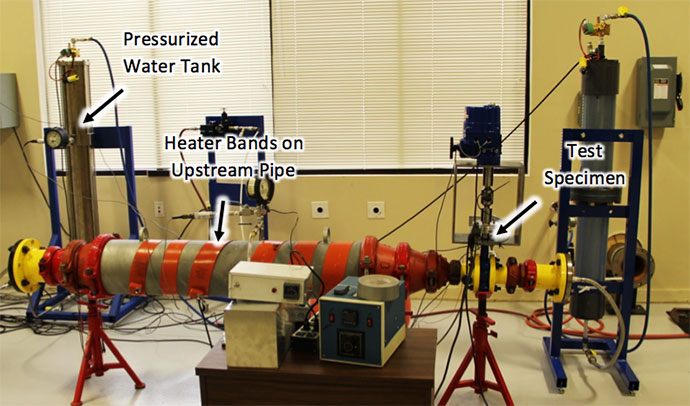KEI™ Flow Loop Testing to Support Commercial Grade Dedication of a Motor-Operated Butterfly Valve
Kalsi Engineering Inc. test labs are well equipped to perform flow loop testing. For over 40 years, our industry-leading engineers have thoroughly assessed our customer testing needs to provide a well structure test environment. Because of our in-depth experience in valve technology, our staff is well capable of performing extensive valve evaluations.
The KEI Flow loop testing has served our organization and clients to determine valve performance coefficients as well as bearing torque and seat torque values. Our testing facility have conducted numerous flow loop test programs critical to the US nuclear industry, including flow loop testing to determine check valve wear and fatigue, butterfly valve required torque, and globe valve required thrust.
Kalsi Engineering Inc. (KEI) labs are equipped to perform commercial grade dedication (CGD) of motor-operated valves (MOV) used in nuclear power plants.
Key commercial grade dedication (CGD) tasks include:
- Determining critical characteristics of the MOV for the dedication program
- Identifying valve and actuator performance requirements
- Performing an in-depth technical evaluation of the MOV test specimen
- Inspection of the MOV test specimen prior to and after dedication testing
- Determining operating margins of the MOV based on operating and installation conditions
- Determining test acceptance criteria
- Performing flow loop testing of the butterfly valve
Flow coefficients and hydrodynamic torque coefficients are examples of valve performance coefficients obtained by our engineers and technicians. These valve performance coefficients are used in our Kalsi Valve & Actuator Program (KVAP) to calculate the required torque to operate the valve for all plant operating conditions. Although our state-of-the-art software, KVAP®, has valve performance coefficients built in that cover a wide range of butterfly and ball valve design, user-defined coefficients based on flow loop testing of the actual disc design test data were used in the evaluation to obtain an accurate operating margin.
The valve test matrix included Seating and Unseating torque tests in addition to flow tests to determine valve performance coefficients. The Seating and Unseating tests were performed at for different values of differential pressure and water temperature. The Seating/Unseating test setup with the short lengths of pipe upstream and downstream of the test specimen is shown in Figure 1.
Analyses in conjunction with actual test data were used to develop relationships between pressure, temperature and torque. The resulting data was then used in the commercial grade dedication for a MOV application.
Details regarding the commercial grade dedication of the motor-operated actuator are provided here.
Contact us today to learn more about our flow loop testing.

